Do you love snacking on dried fruit like dried mango? How about chili lime dried mango? It is a favorite way to preserve fresh mangoes.
I'm going to show you how to dehydrate mango at home in just a few simple steps. This is one of my favorite Food Dehydrator recipes here in Florida where mango grows in many back yards.
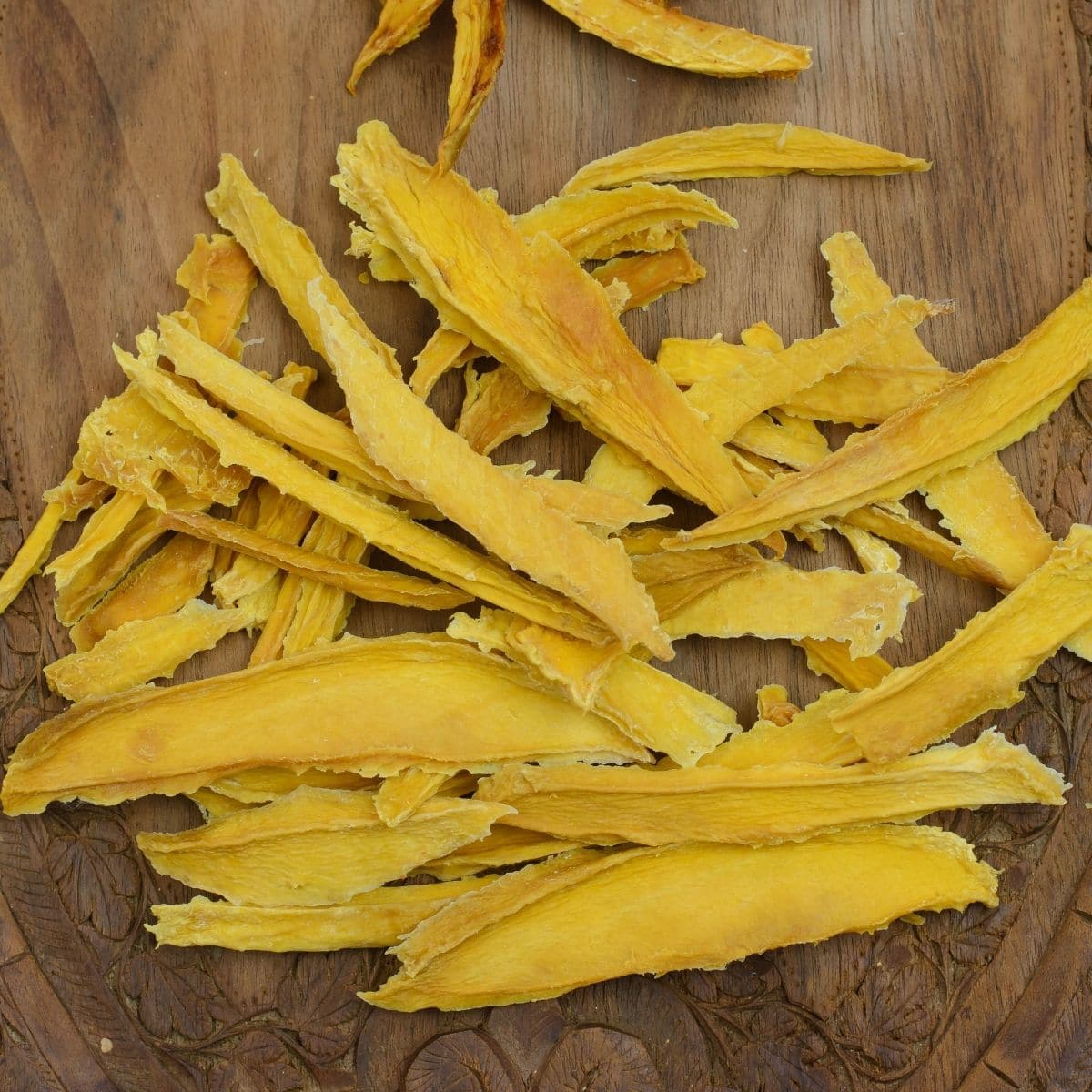
Fruit is one of the easiest foods to dehydrate.
All you do is slice the fruit and load it into the food dehydrator. The appliance does all the work for you.
Chewy dehydrated mango is a naturally sweet tropical fruit snack that is so easy to make you'll wonder why you have been paying for it.
Mango Season
Mango season starts in May and runs through September with the peak of the season in July.
You will be able to buy fresh mango at a great price during the peak of mango season.
This tropical fruit has a very short shelf life.
Once the fruit is ripe you have to eat it quickly or you will have to toss it.
How to preserve ripe mangoes for a long time
If you have ever had a lot of fresh mangos you bought or picked off a mango tree you know that the fresh mango can quickly start to overripen.
It can be hard to eat all that ripe mango before they start to spoil.
If you want to enjoy the sweet tropical flavors of fresh mango long after mango season you'll need to preserve it.
Before the fresh mangoes start to go bad you can make dehydrated mango slices.
Or you can freeze fresh mango to use in recipes or to make mango smoothies.
Dehydrating is an easy way to preserve this tropical fruit for long time storage so you can enjoy mango for many months after mango season.
Ingredients needed
Ingredients needed to make dried mango are below. You'll need fresh mangoes and a few other ingredients if you want to make a dried spicy mango treat.
- fresh mangoes
- water
Step by step directions to dehydrate mango
Follow my easy step by step directions to make dried mango fruit.
Step 1: Wash each fresh mango under cold water to remove any dirt or insects from the fruit.
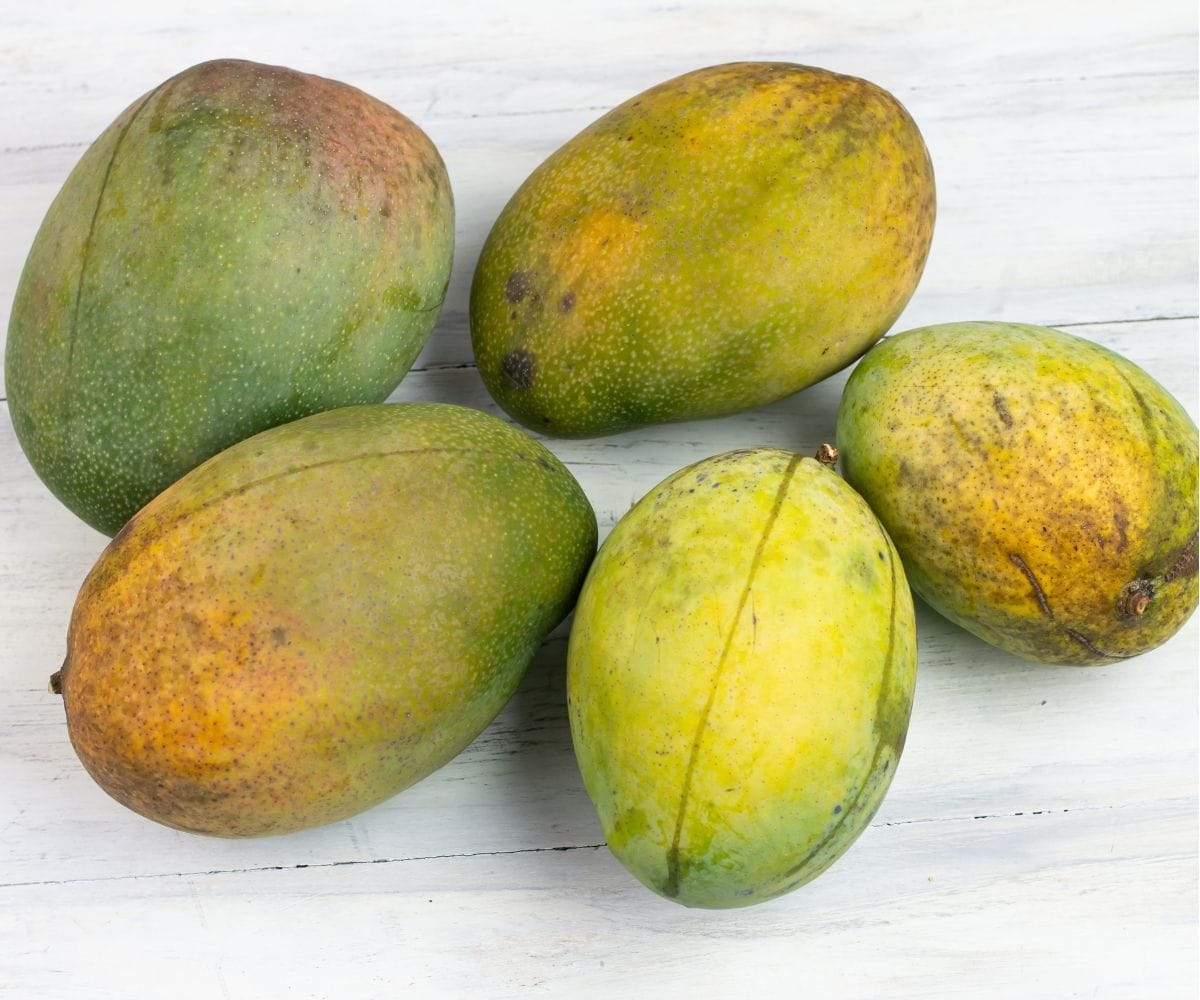
Step 2: Cutting the mango. Hold the mango up on a cutting board with the narrow end pointing up. Use a sharp knife to slice the fruit from each side of the pit.
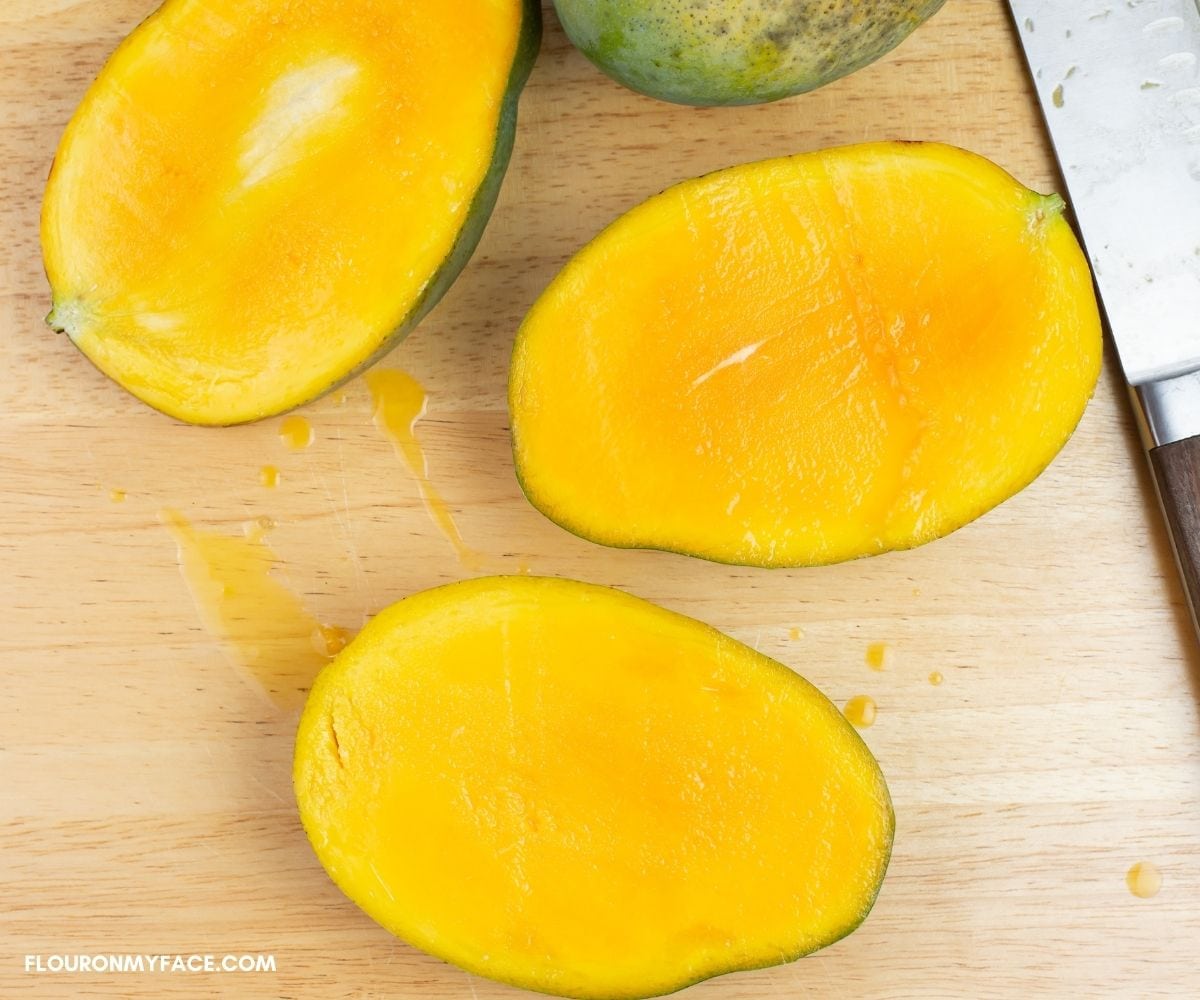
Step 3: Cut each half of the mango into long narrow strips about ¼ inch thick.
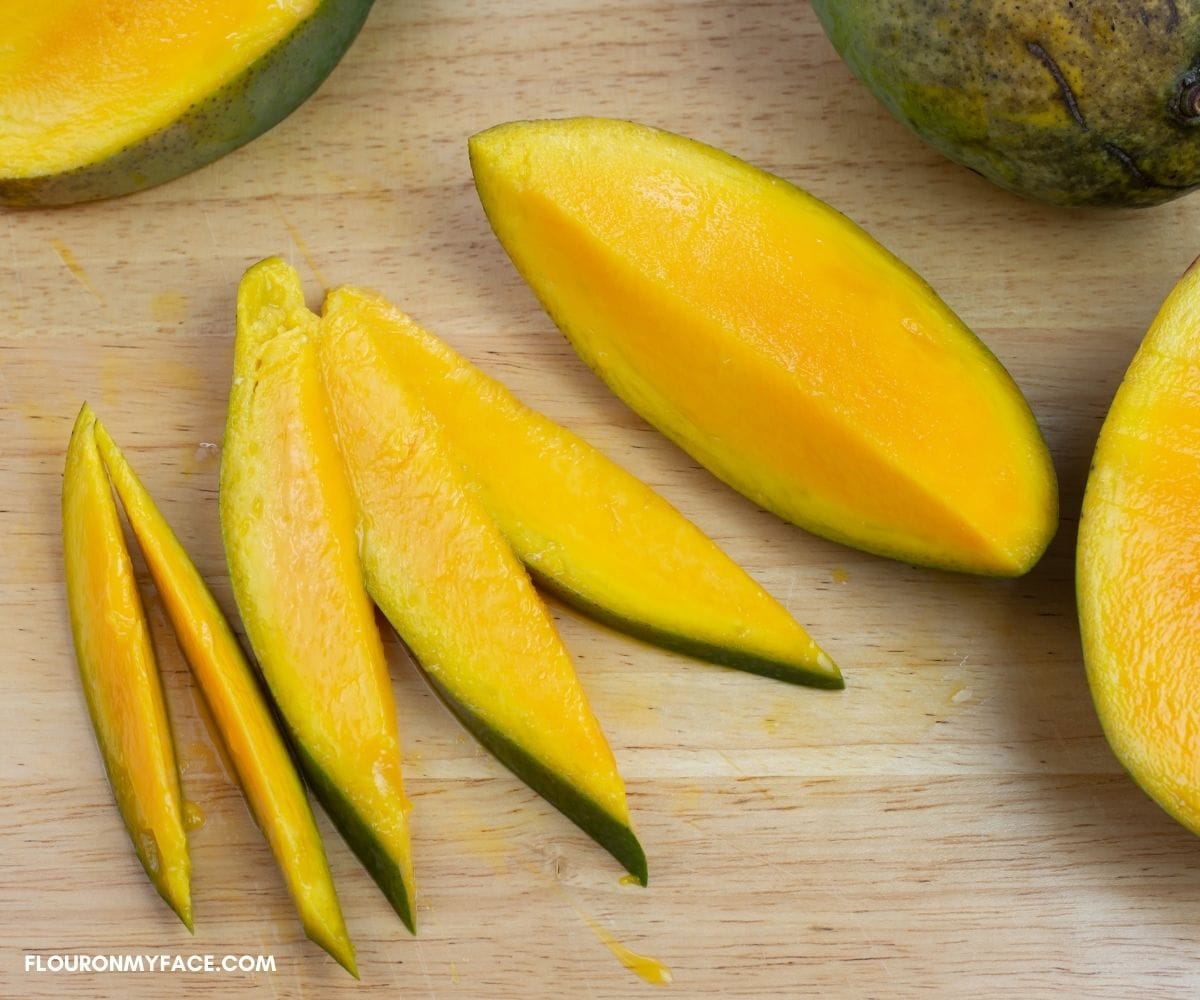
Step 4: Remove the skin from each of the mango slices. Slid a thin paring knife in between the skin and the flesh of the mango.
Slid the knife along the skin to cut the fruit away in one long piece.
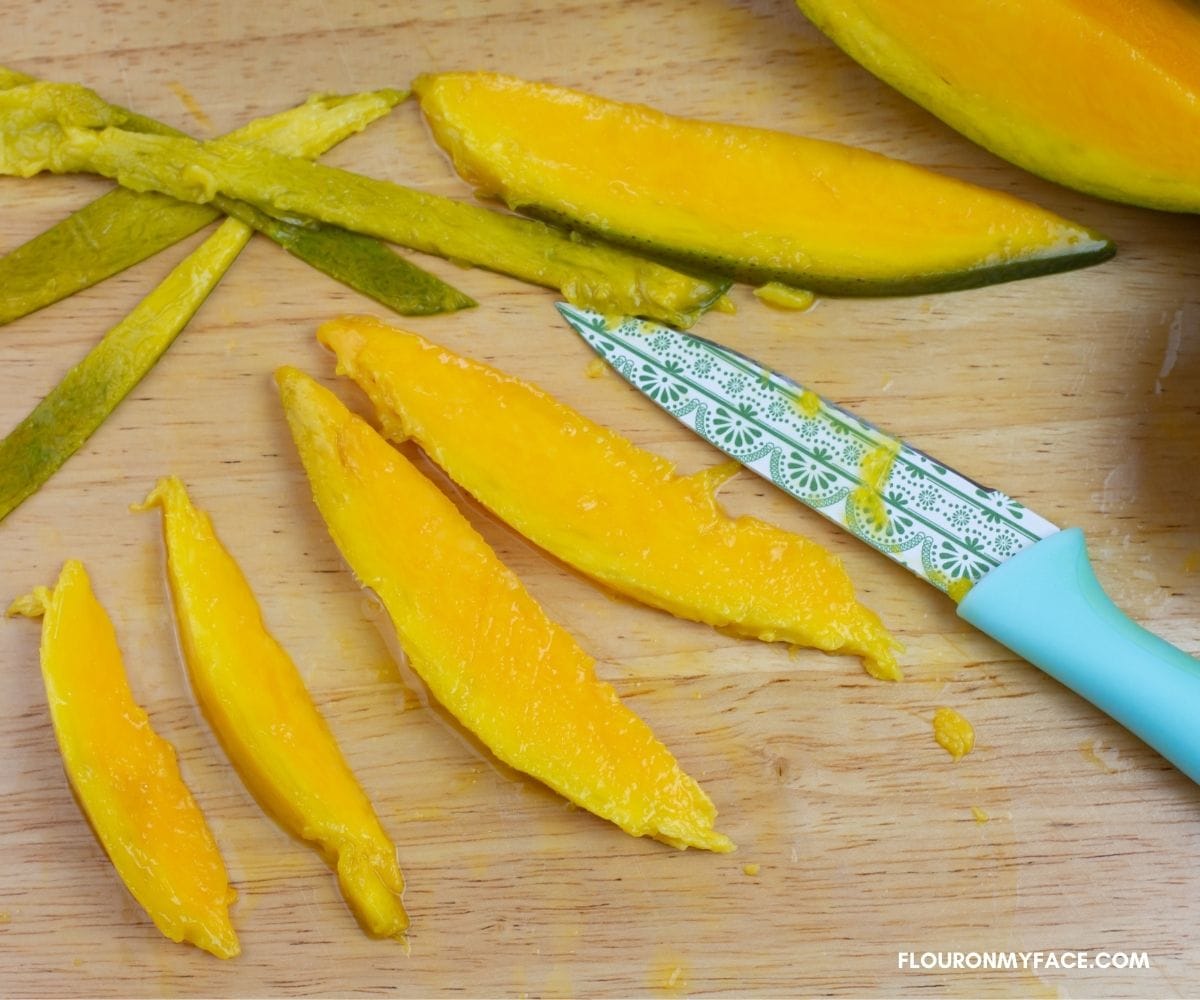
Step 5: Arrange the sliced pieces in a single layer on a food dehydrator tray.

Repeat filling each dehydrator tray until you run out of mango pieces. Stack the trays on the dehydrator.
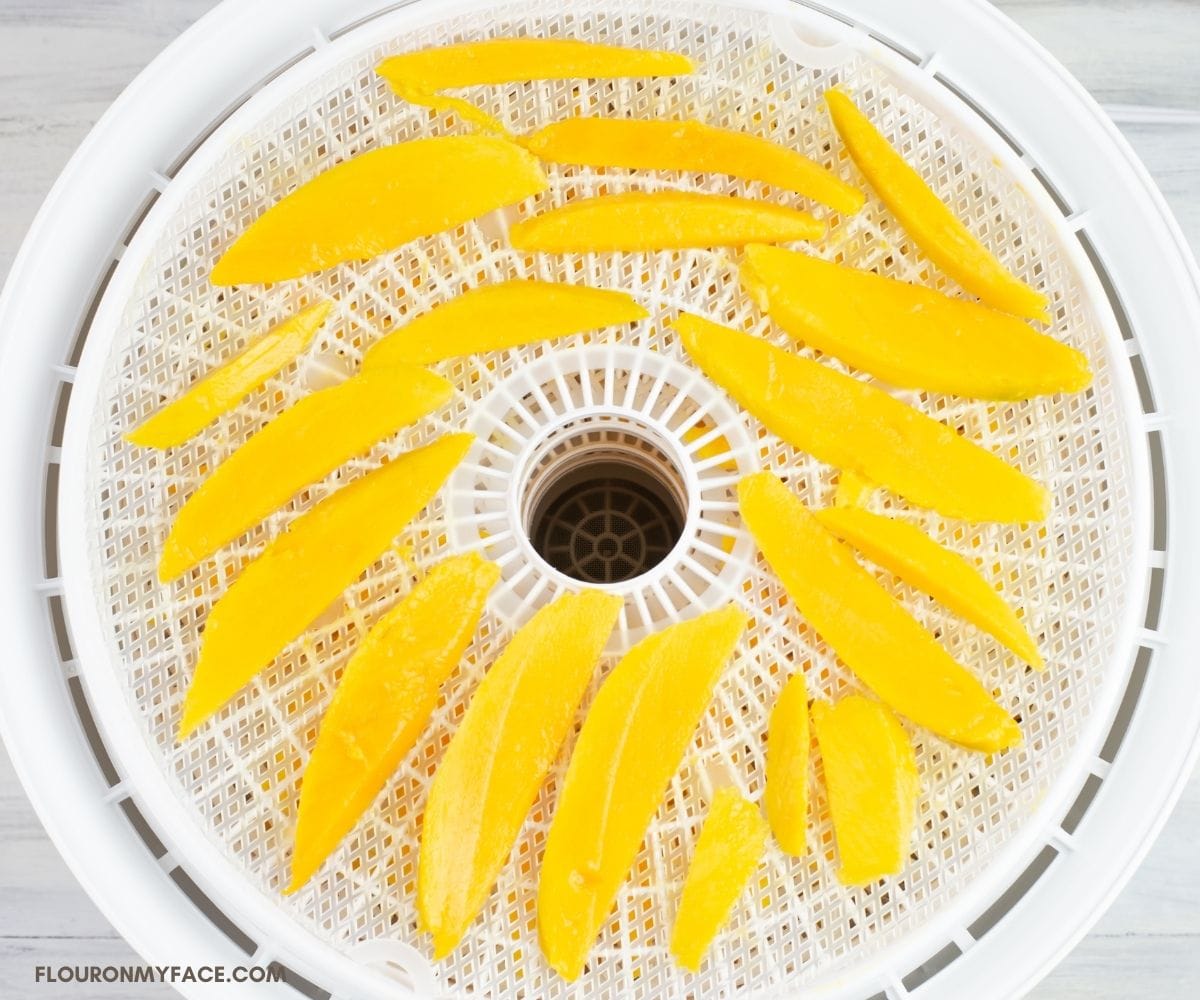
Step 6: Place the lid on top of the dehydrator and set the temperature to 135 F. degrees or the fruit setting if using an Excalibur type dehydrator.
Step 7: Dehydrate the mango for 8 to 12 hours or until the mango pieces are dry to the touch and pliable.(see notes)
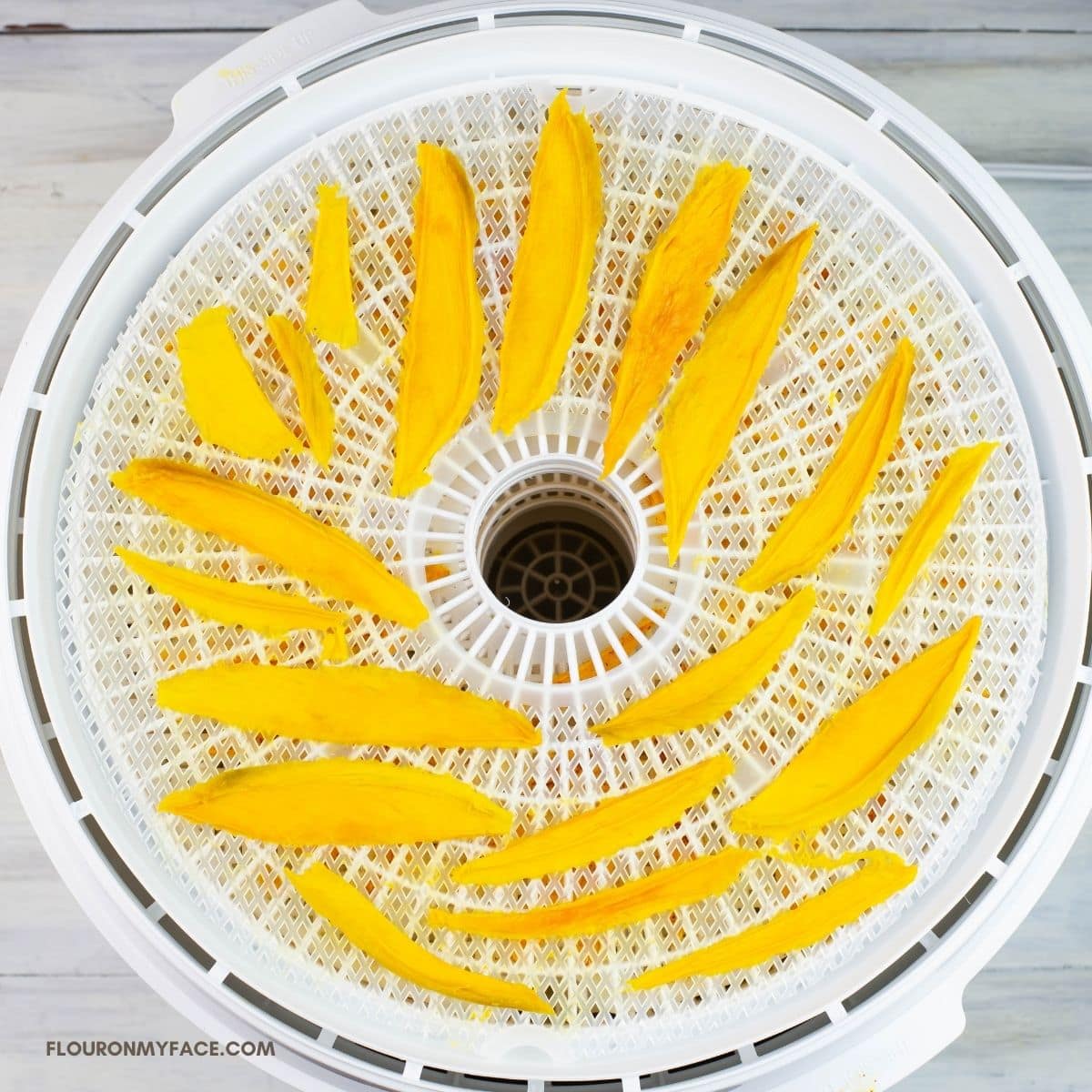
Step 8: Transfer the dried mango pieces to a paper plate and allow to cool completely before storing in air tight containers.
Conditioning dried fruit
Conditioning home dried fruit is recommended before long term storage.
Conditioning the dried fruit helps cut back on mold.
If there are any dried pieces of fruit with any moisture left the other dried pieces will absorb the moisture.
Pack the dried mango slices loosely into plastic or glass mason jars. Seal the jars with a lid for 7 to 10 days.
Place the jar out of direct light and each day shake the jars.
Check the jars each day for any moisture that has formed on the inside of the jars. If you see an excessive amount of moisture form on the inside of the containers return the fruit to the dehydrator and dry until completely dry.
Recipe FAQS
Below are some frequently asked questions and answers about drying fresh mango.
Slice the fresh mango into ¼ inch thick pieces and arrange on a dehydrator tray. Dried the mango until it is still pliable.
Dried mango is very easy to make at home. I like to use a dehydrator to dry fresh fruit. A dehydrator is easy to use. Just slice up the fresh mango and set the dehydrator to 135 F. degrees. Depending on how thick the piece of mango are it can take any where from 4 hours to 12 hour to dry.
Mango like all other fruits should be dehydrated at 135 F. degrees.
Recipe Expert Tips
Here are some expert mango dehydrating tips that will help you when dehydrating mangoes.
- The fruit: The best dried fruit is made with ripe unblemished fruit. Fully ripened fruit will have the sweetest flavor when dehydrated. The natural sugars will intensify with the drying process.
- Firm fruit: You will want to use firm but fully ripened mangos. If the fruit is overripe it will be very difficult to cut into slices. Slightly under ripe or green mango fruit is better for drying than over ripened fruit.
- Cutting the mango slices: If the mango is soft it may be difficult to cut it into ¼ thin slices. The thicker slices will take longer to dry.
- The dehydrating temperature: Whenever dehydrating fruit you should set the dehydrator temperature to 135 F. degrees. If you are using a dehydrator like the Excalibur use the fruit setting.
- If you are using a dehydrator that does not have a temperature setting, no worries. You can still make dried mango but you will need to pay close attention to the fruit slices as they dry. Watch the drying fruit carefully. Check the fruit slices every couple of hours and flip the thicker pieces of mango over to help them dry evenly.
- How long to dehydrate mango?: Drying times will vary depending on the shape and thickness of the fresh mango slices you have loaded onto the dehydrator tray. It took 12 hours for the sliced mango to dry completely.
- How to store?: Dried fruits and other foods should be stored in air tight containers out of direct sunlight. Store in a dark pantry or cabinet. Properly dried and stored fruit will last years. If the fruit is vacuumed sealed it can last 10 or even as much as 20 years.
- Chewy dried mango slices: If you like chewy dried mango only dehydrate it until it is pliable and will bend easily. Check the fruit every couple of hours to see how dry it is. Dried mango will be slightly tacky and bend easily. If the fruit pieces feel "wet" it has not dried enough for safe storage.
- Conditioning fruit: Condition the dried fruit to prevent mold.
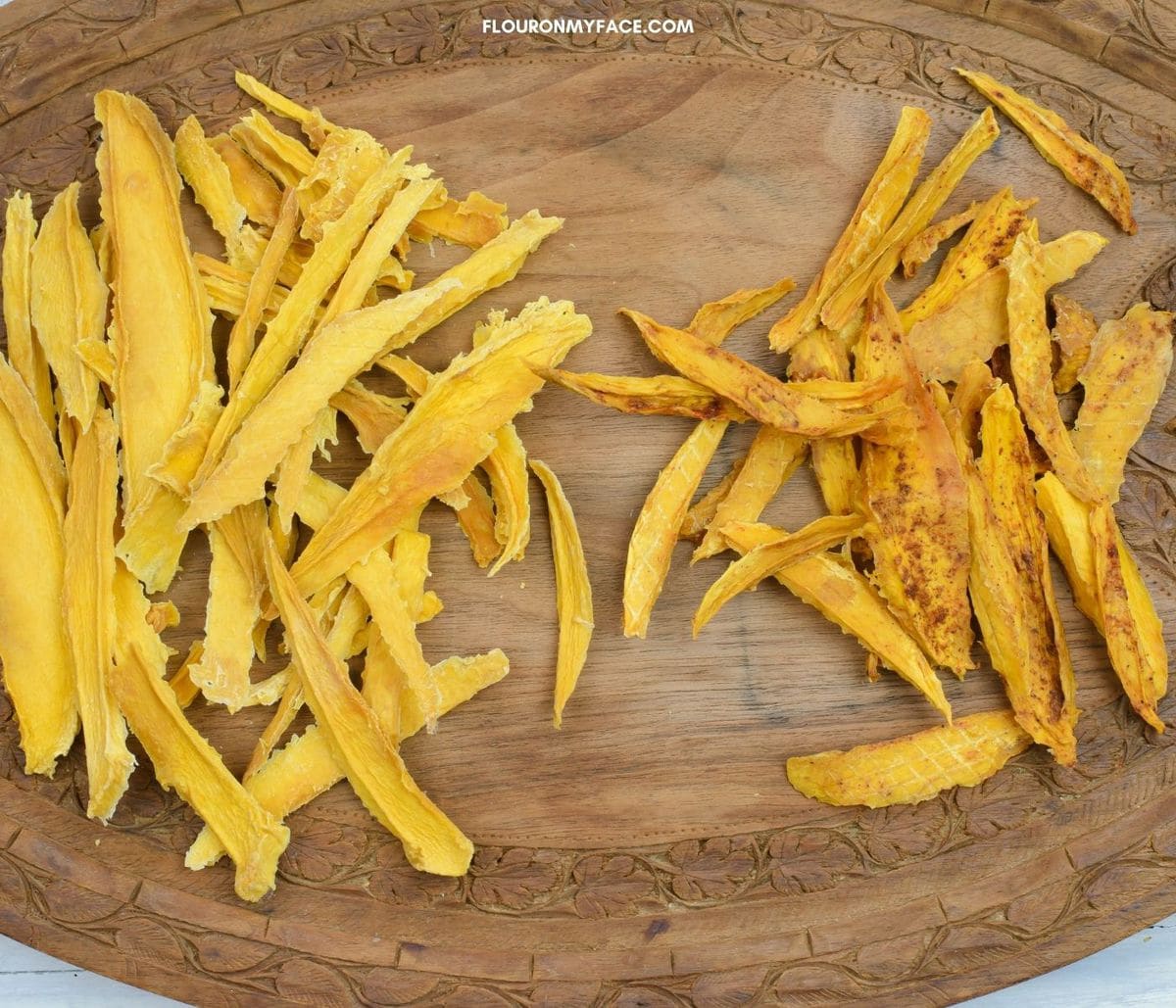
How to make chili lime dried mango
If you love dehydrated mango with chili you can make a few trays of dried chili lime mango.
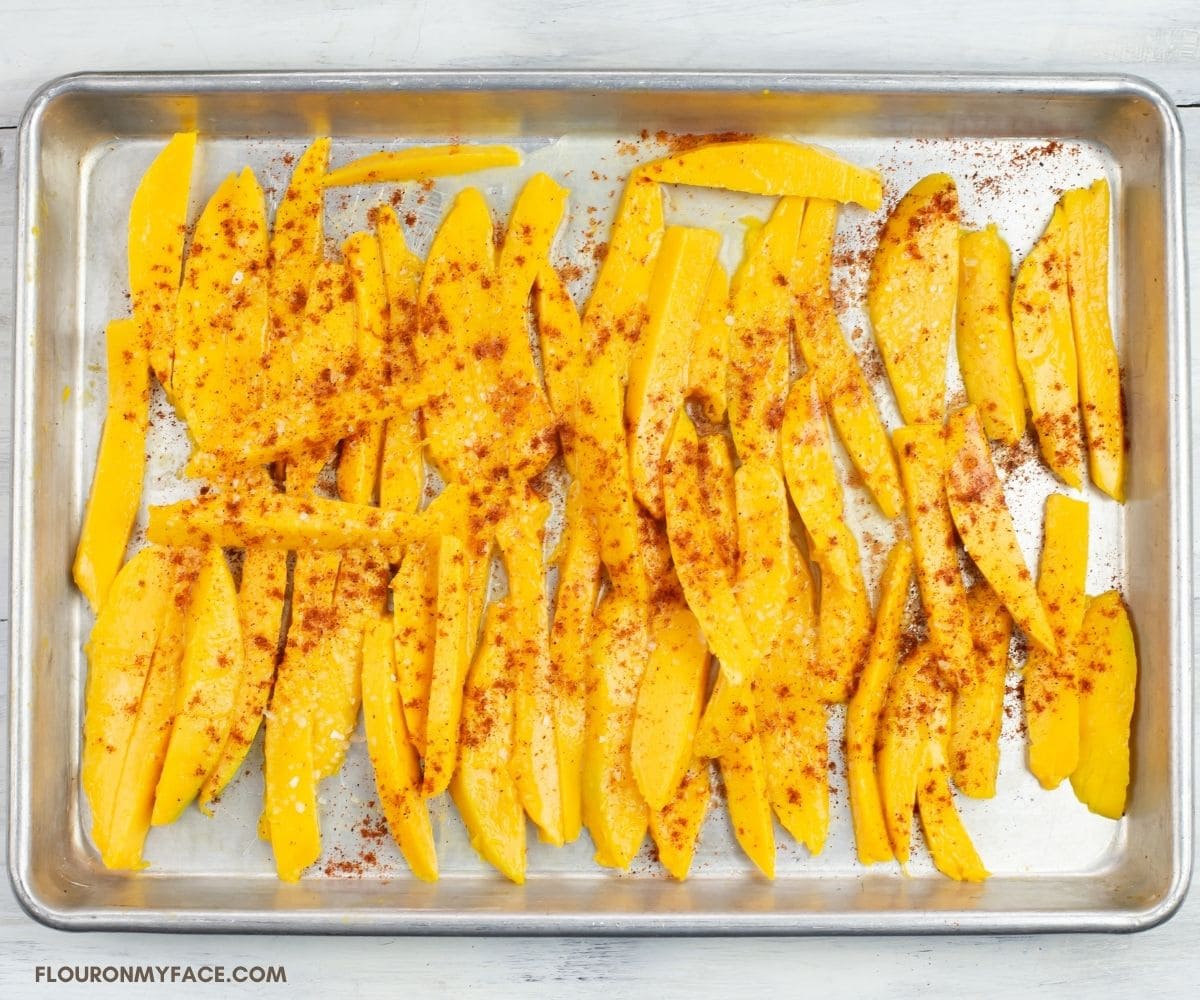
Dried Chili Mango Recipe
Dried chili lime mango recipe is very easy to make. You'll need sliced mangoes, chili powder, lime juice and sea salt to make it.
- juice of one fresh lime
- sea salt
- ground chili powder
Follow the direction to make dehydrated mangoes but before loading the mango slices on to the dehydrator trays sprinkle the pieces with the juice of one lime, ground chili powder and sea salt.
Dry the chili flavored mangoes in the dehydrator. It will take a little longer to dehydrate the dried chili mango pieces because of the added moisture of the lime juice and sea salt.
Dried Mango Uses
What can you use dried mango for? Most people will enjoy it as a dried fruit snack. But you can also blend the dried pieces of fruit into a powder that can be added to other recipes when you want to add a mango flavor.
More fruit dehydrating recipes
How to print, share or save the recipe below.
Email questions or recipe requests to flouronmyface@gmail.com. Follow me on Pinterest, YouTube, Instagram and Facebook.
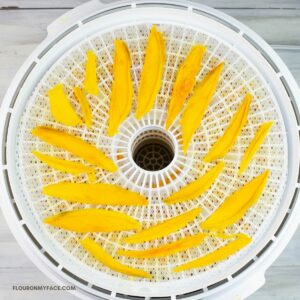
How to dehydrate Mango
Ingredients
How to dehydrate mango
- 5 large fresh ripe mangoes
- 1 pan water
Dried Chili Lime Mango
- 1 whole lime (juiced)
- sea salt
- chili powder
- mango slices
Instructions
- Wash the fresh mangoes well under cold running water.
- Cut the flesh from the 2 sides of each mango.
- Slice each piece into smaller ¼ inch thick slices.
- Use a sharp knife to cut the flesh of the mango from the skin.
- Arrange the sliced pieces in a single layer on a food dehydrator tray. Repeat filling each dehydrator tray until you run out of mango pieces. Stack the trays on the dehydrator.
- Place the lid on top of the dehydrator and set the temperature to 135 F. degrees or the fruit setting if using an Excalibur type dehydrator.
- Dehydrate the mango for 8 to 12 hours or until the mango pieces are dry to the touch and pliable.(see notes)
- Transfer the dried mango pieces to a paper plate and allow to cool completely before storing in air tight containers.
- Store the dried mango in air tight containers in a cool dark cabinet.
Video
Recipe Expert Tips
- The fruit: The best dried fruit is made with ripe unblemished fruit. Fully ripened fruit will have the sweetest flavor when dehydrated. The natural sugars will intensify with the drying process.
- Firm fruit: You will want to use firm and fully ripe mangos. If the fruit is overripe it will be very difficult to cut into slices. Slightly under ripe or green mango fruit is better for drying than over ripened fruit.
- Cutting the mango slices: If the mango is soft it may be difficult to cut it into ¼ thin slices. The thicker slices will take longer to dry.
- The dehydrating temperature: Whenever dehydrating fruit you should set the dehydrator temperature to 135 F. degrees. If you are using a dehydrator like the Excalibur use the fruit setting.
- If you are using a dehydrator that does not have a temperature setting, no worries. You can still make dried mango but you will need to pay close attention to the fruit slices as they dry. Watch the drying fruit carefully. Check the fruit slices every couple of hours and flip the thicker pieces of mango to help them dry evenly.
- How long to dehydrate mango?: Drying times will vary depending on the shape and thickness of the fresh mango slices you have loaded onto the dehydrator tray. It took 12 hours for the sliced mango to dry completely.
- How to store?: Dried fruits and other foods should be stored in air tight containers out of direct sunlight. Store in a dark pantry or cabinet. Properly dried and stored fruit will last years. If the fruit is vacuumed sealed it can last 10 or even as much as 20 years.
- Chewy dried mango slices: If you like chewy dried mango only dehydrate it until it is pliable and will bend easily. Check the fruit every couple of hours to see how dry it is. Dried mango will be slightly tacky and bend easily. If the fruit pieces feel "wet" it has not dried enough for safe storage.
- Conditioning fruit: Condition the dried fruit to prevent mold. Pack the dried mango slices loosely into plastic or glass mason jars. Seal the jars with a lid for 7 to 10 days. Place the jar out of direct light and each day shake the jars. Check the jars each day for any moisture that has formed on the inside of the jars. If you see excess moisture return the fruit to the dehydrator and dry until completely dry.
Nutrition
More food dehydrator recipes






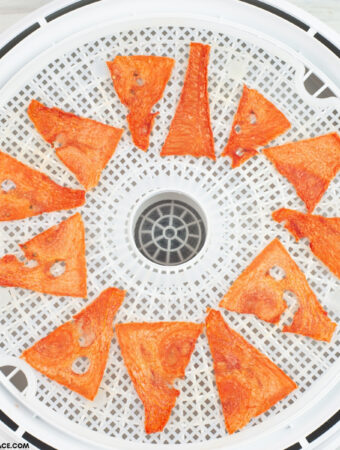
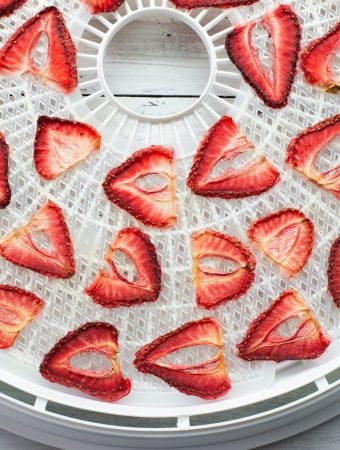
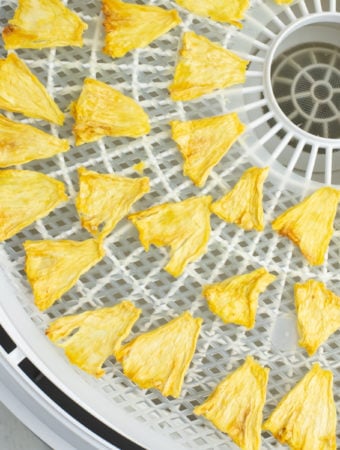
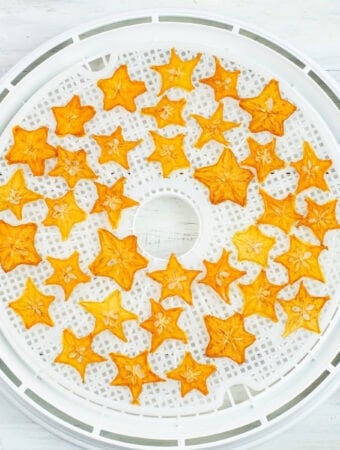


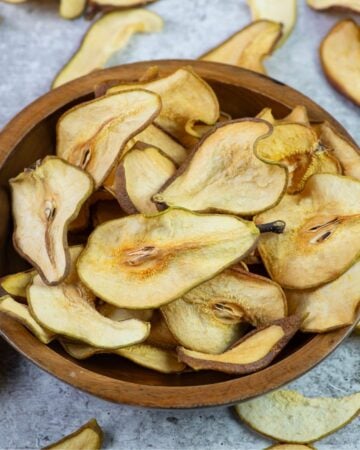

Leave a Reply